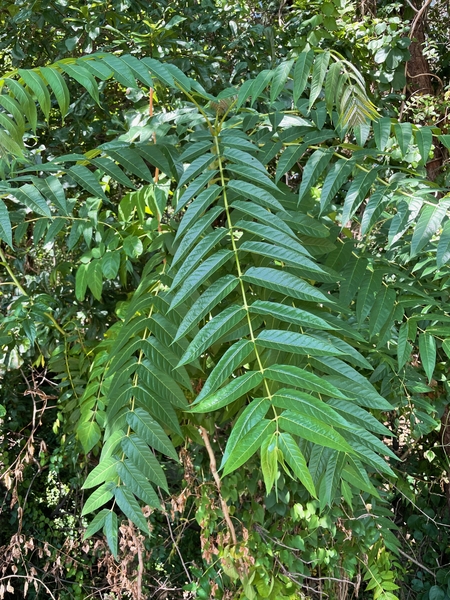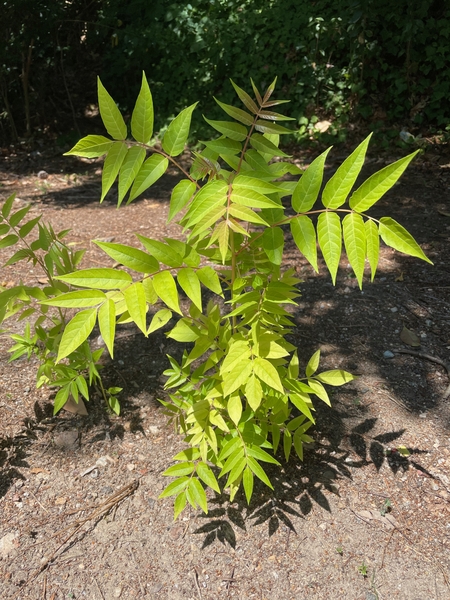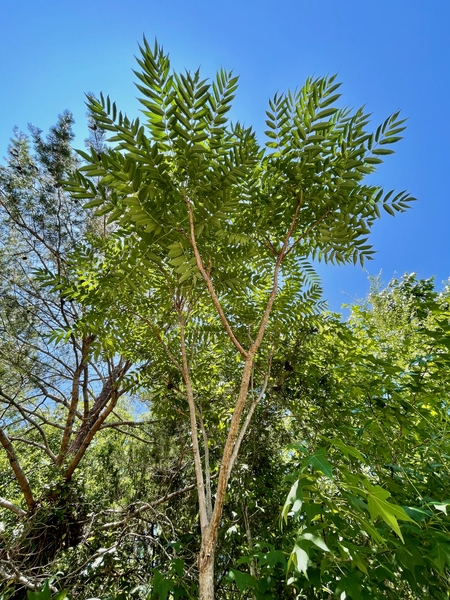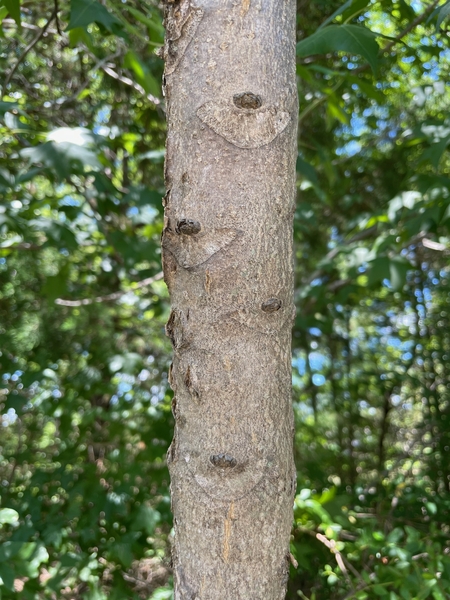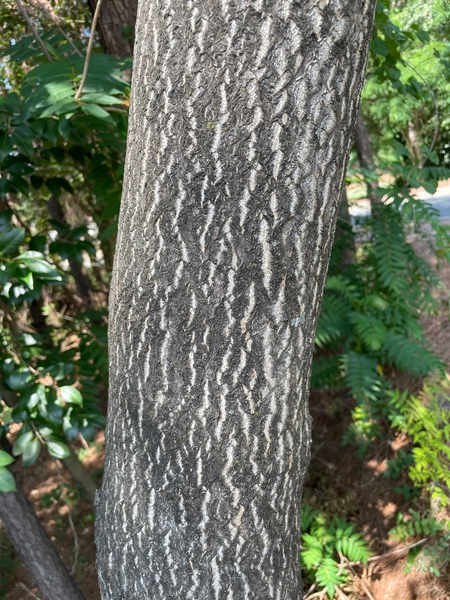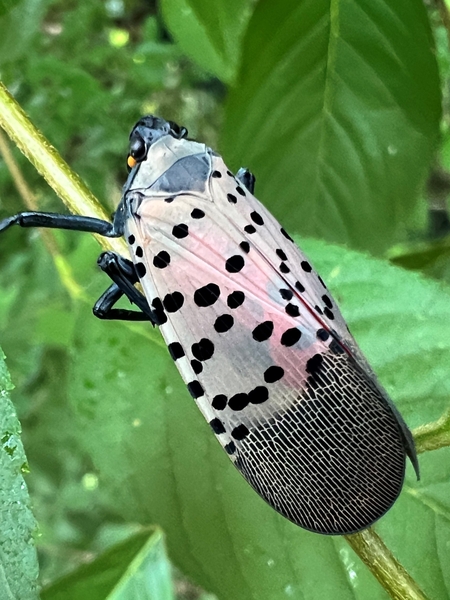Introduction
Ailanthus altissima, commonly known as tree-of-heaven or simply Ailanthus, is a species of tree native to eastern Asia. This tree was first introduced to the United States as an ornamental plant in the late 1700s (Hu 1979). Unfortunately, tree-of-heaven has since become a problematic invasive species across much of the country. Tree-of-heaven is one of the most prevalent invasive trees in North Carolina, and learning to identify and manage this tree can help reduce its negative impacts on the environment.

Large tree-of-heaven with clusters of samaras (fruits).
Ryan Bohannon, NC State University CC BY 4.0
Identification
Tree-of-heaven is typically a fairly small tree, but it is able to grow up to 80 feet tall. The most striking features of this tree are its very large leaves, which can measure up to two to four feet long. Tree-of-heaven has compound leaves, which means that each leaf is composed of many smaller leaflets. A tree-of-heaven leaf can have 10 to 40 individual leaflets attached along a main stem. Leaflets have smooth edges and blunt teeth with raised glands at the base. The smooth leaflet margins distinguish tree-of-heaven from similar native trees with compound leaves, such as black walnut (Juglans nigra) and sumac (Rhus spp.), that have many small teeth, or serrations, along the edge of their leaflets.
Tree-of-heaven leaves and other parts will release a strong, unpleasant odor that is often compared to rancid or burnt peanut butter. Tree-of-heaven loses its leaves in the fall, and a large leaf scar is left on the branch where a leaf was attached. This tree’s bark is smooth and gray or brown, and lighter-colored vertical crevices appear on older stems. Tree-of-heaven produces clusters of winged fruits called samaras. Each samara consists of a flat, twisted wing with a round seed near its center.
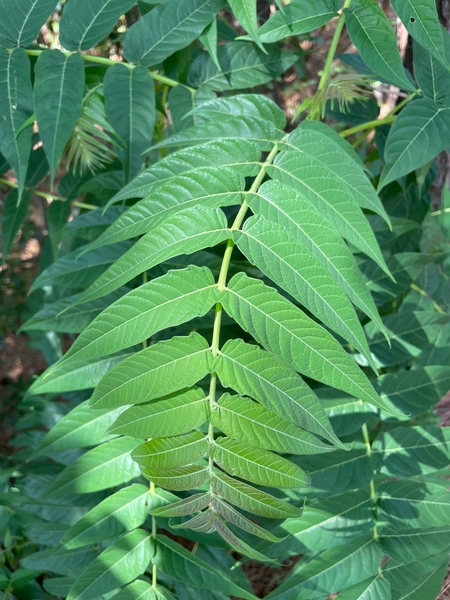
Tree-of-heaven leaves are composed of many individual leaflets.
Ryan Bohannon, NC State University CC BY 4.0

Underside of leaflets, showing the glands at the tip of the leaflets’ teeth.
Ryan Bohannon, NC State University CC BY 4.0
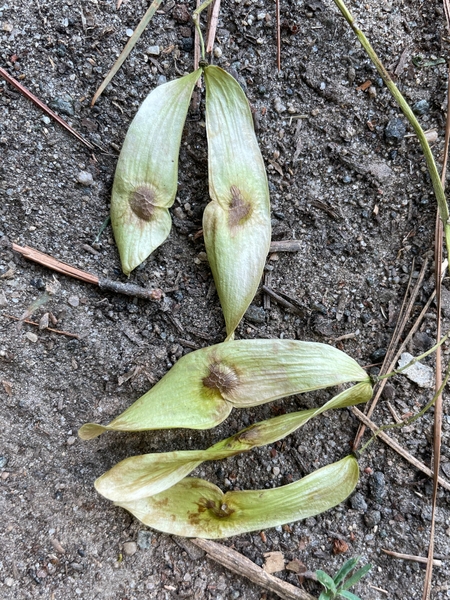
Each samara (fruit) is composed of a flat, twisted wing with a seed near its center.
Ryan Bohannon, NC State University CC BY 4.0
Impacts
Dense patches of tree-of-heaven are a common sight along roadsides in North Carolina as it thrives in disturbed areas, but it also invades forests. Tree-of-heaven is considered an invasive plant because it is able to outcompete and displace native plants species. A variety of characteristics allow this tree to be so prolific. Tree-of-heaven has a very fast growth rate, and it can sprout vigorously from its roots. This sprouting ability, paired with its production of many wind-blown seeds, allows tree-of-heaven to reproduce quickly and abundantly. Tree-of-heaven also releases chemicals that inhibit the growth of nearby plants (Lawrence et al. 1991). This tree is tolerant of a wide range of environmental conditions, allowing it to establish and thrive on sites with poor soils and pollution.
Spotted Lanternfly Host Plant
Tree-of-heaven is also important because it is a major host plant of the spotted lanternfly (SLF; Lycorma delicatula), an invasive insect that is an agricultural, ornamental, and nuisance pest. The first established population of SLF was confirmed in North Carolina in June 2022. While SLF will feed on a variety of plants, examining tree-of-heaven growing in your area could help monitor for new SLF infestations because of its preference for feeding on this species. If you find a suspected SLF, please take a photo and report it to the North Carolina Department of Agriculture and Consumer Services.
Management
Removing tree-of-heaven can promote the growth of native plants and remove a preferred host plant for SLF. Although controlling this tree can be difficult, several management options have been developed. Seedlings can be removed manually if the entire root system is removed. Simply cutting down tree-of-heaven will not kill this tree because it will resprout. If a tree is removed, the stump must be treated with an herbicide (e.g. triclopyr) to prevent this. To control larger trees without removal, an appropriate herbicide such as glyphosate or triclopyr can be applied using foliar, basal bark, or hack-and-squirt applications. Herbicide recommendations for this species are provided by the North Carolina Forest Service. In addition to mechanical and chemical control, scientists are investigating biological control as a method for managing tree-of-heaven. This approach involves infecting tree-of-heaven with a native fungus called Verticillium that spreads and kills tree-of-heaven but poses little risk to native trees (Pile Knapp et al. 2022).
References
Hu, S. Y. 1979.Ailanthus. Arnoldia 39(2): 29–50.
Lawrence, J. G., A. Colwell, and O. J. Sexton. 1991. The ecological impact of allelopathy in Ailanthus altissima (Simaroubaceae). American Journal of Botany 78(7): 948–958.
N.C. Cooperative Extension. n.d. Ailanthus altissima.
N.C. Forest Service. 2010. Ailanthus altissima (tree-of-heaven). Invasive Species Leaflet No. 01. Excerpted from: Smith, C. 2008. Invasive exotic plants of North Carolina. N.C. Department of Transportation. Raleigh, NC.
Pile Knapp, L. S., J. Rebbeck, T. Hutchinson, J. Fraser, and C. C. Pinchot. 2022. Controlling an invasive tree with a native fungus: inoculating Ailanthus altissima (tree-of-heaven) with Verticillium nonalfalfae in highly disturbed Appalachian forests of Ohio. Journal of Forestry 1–17.
Washington State Noxious Weed Control Board. n.d. Tree-of-heaven.
Wurzbacher, S., D. R. Jackson, and A. Gover. 2020. Tree-of-heaven.
Publication date: July 29, 2022
N.C. Cooperative Extension prohibits discrimination and harassment regardless of age, color, disability, family and marital status, gender identity, national origin, political beliefs, race, religion, sex (including pregnancy), sexual orientation and veteran status.

